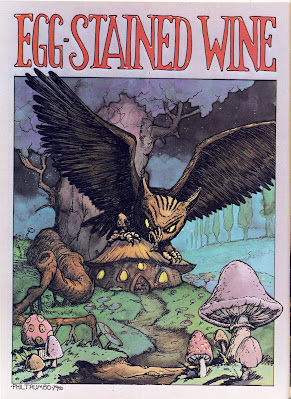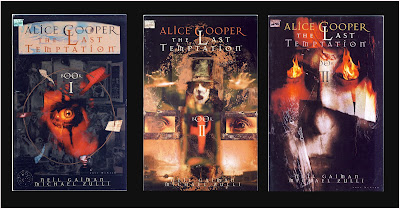2 / 5 Stars
Damon Knight’s ‘Orbit’ anthologies, 21 of which appeared sometimes twice-yearly from 1966 to 1980, were quintessential New Wave story collections. Earlier volumes (i.e., 1 - 15) featured attractive cover art, usually of an abstract or figurative nature.
As the Editor of the Orbit series, Knight was on a mission to demonstrate that SF was not a frivolous, adolescent-centered endeavor, but in actuality a subdivision of the emerging genre of ‘speculative fiction’ that offered a quality of prose that was equivalent to that of mainstream Literature.
I remember checking some of the volumes out from the library in the early 70s, and I remember being underwhelmed by the story selection.
So are things better when read with adult eyes almost forty years later ?
My brief comments on the stories in ‘Orbit 6’ (Berkley, 1970, 222 pp.):
‘The Second Inquisition’ by Joanna Russ: the narrator is a teenage girl whose family takes in a mysterious woman boarder in the summer of 1925. ‘Inquisition’ mixes elements from C. L. Moore’s classic tale ‘Vintage Season’ with bits of F. Scott Fitzgerald; this is not necessarily a bad thing, but Russ uses an oblique prose style that tends to make the story a laborious read. When overt SF elements appear at the climax of the story, they are introduced in a rather clumsy manner. A tale that would have benefited greatly from good editing.
‘Remembrance to Come’ by Gene Wolfe: set in a student-controlled college campus of the near future, the narrative deals with an instructor who may be having a nervous breakdown. Readers will probably guess the underlying ‘surprise’ element well ahead of the story’s ending.
Wolfe also contributes another story, ‘When the Whip Came Back’, a dull entry about a socialite-turned-activist who is asked to endorse a global mandate to dispose of the prisoner population in a new and troubling way. These two stories by Wolfe reinforce my assumption that he is one of the more over-rated SF writers to have emerged from the New Wave era.
‘Goslin Day’ by Avram Davidson: a very brief story in an absurdist vein. Solomon Faroly witnesses the advent of a plague of Jewish gremlins. Davidson mixes stream-of-consciousness wordplay with Yiddish terms in an effort to be Avante Garde; like catnip to the witless Damon Knight. This is one of the more hapless entries in the anthology.
‘Maybe Jean-Baptiste Pierre Antoine de Monet, Chevalier de Lamarck, Was A Little Bit Right’ by Robin Scott: only in the New Wave era could a short story with such a title have been considered the height of style. The story deals with the last woman and the last two men on earth; it tries to say something caustic and cynical about human nature, but does so in a profoundly uninteresting manner.
‘The Chosen’ by Kate Wilhelm: a man on a time-traveling mission wanders an idyllic far-future earth; he resolves to stay rather than return to his point of origin. There is something of a surprise ending.
‘Entire and Perfect Chrysolite’ by R. A. Lafferty: another overly artsy title. This story deals with recreational hallucinations and their unpleasant side effects. Lafferty had quite a bit of stature during the New Wave era, but this story has aged poorly.
‘Sunburst’ by Roderick Thorpe: this story’s unadorned, direct prose style makes it seem out of place in the anthology, but it’s a competent tale of sunspots and their less than salutary effect on human nature.
‘The Creation of Bennie Good’ by James Sallis: another absurdist tale with negligible merit; it’s plain that editor Knight selected it to demonstrate his ardor for ‘Speculative Fiction’.
‘The End’ by Ursula Le Guin: as a rustic seaside village decays into madness and suicide, a brickmaker tries to make real a dream of leaving for islands far offshore. Moody and slow-paced, with an ambiguous ending; more fantasy than SF, but nonetheless one of the better entries in the anthology.
‘A Cold Dark Night With Snow’ by Kate Wilhelm: A young wife has doubts about her husband’s work on a secret government project. Wilhelm tries to be a dedicated New Wave stylist by confronting the reader with several narrative threads representing different events taking place at different times; almost inevitably, the end result is….not impressive.
‘Fame’ by Jean Cox: an ambitious spaceman embarks on the first trip to Proxima Centauri; traveling at near-relativistic speeds means he will return to earth a century after departure, hopefully to receive a hero’s welcome. The ending features the sort of twist encountered in the stories of Roald Dahl. One of the better entries in the anthology.
‘Debut’ by Carol Emshwiller: a tale that weaves hints of ancient mythology into its first-person narration of a young girl destined for a sacred duty.
‘Where No Sun Shines’ by Gardner Dozois: in the near future, rebellion and social unrest grip the US; a man driving on the back roads of New Jersey becomes an unwilling participant in a violent confrontation. This also is one of the better stories in the collection.
‘The Asian Shore’ by Thomas Disch: an American tourist in Turkey finds himself haunted by two of the locals. Of all the stories in Orbit 6, this one suffers the most from a self-conscious effort to be ‘literary’. More a vague, existential horror story than SF, the tale is hampered by too many superficially profound but empty sentences.
For example:
It was the thesis of his first book that the quiddity of architecture, its chief claim to an esthetic interest, was its arbitrariness.
(‘quiddity’ is a rarely-used noun that refers to the intrinsic character or essence of a thing)
Whatever momentum the narrative possessed at its start leaks away as the tale unfolds, and by the time I reached its midway point I found continued reading to be a chore. The story’s ending is predictable; it’s insult to injury that I had to wade through such turgid prose to get there.







































































